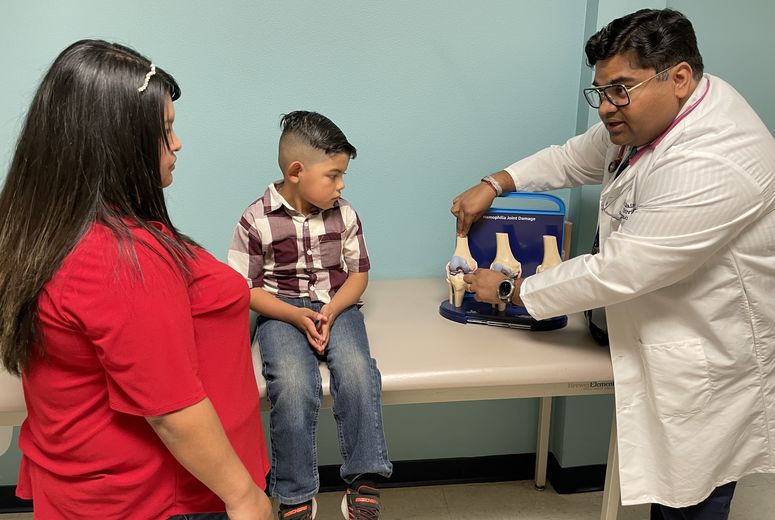
Kevin Sanchez Baca presented as a challenge to doctors trying to treat him after he fell while playing with his siblings. The one-year-old had injured the connecting tissue from his lip to his gums and began bleeding. And Kevin kept bleeding every time he ate. It wasn’t until the third trip to the emergency department that his parents found out why.
Kevin had hemophilia, a blood disorder in which the person’s coagulation system lacks the ability to produce blood clotting factors that are critical in arresting a bleed every time the body undergoes a trauma. The only way these patients can be kept alive without bleeding out, is by intravenous clotting factor infusion two or three times a week. A simple paper cut could be fatal.
Akshat Jain, MD, MPH, director of Inherited Bleeding Disorders at Loma Linda University Children's Health diagnosed a rare genetic aberration in Kevin. Genome sequencing conducted on Kevin’s blood led to the identification of a rare mutation known to afflict families suffering from hemophilia. Unfortunately, Kevin was the first member of his family to develop this mutation, known as inhibitor development—which renders standard lifesaving treatments ineffective.
Hemophilia treatments for Hispanics, African Americans, and Indigenous people are often complicated by the development of this rare complication. This makes the disease fatal for people in these groups at double the rates of Caucasian hemophilia patients, Jain says.
With demographics in the Inland Empire, Jain says many patients coming to Loma Linda University Health for hemophilia treatment have higher rates of inhibitor development given their ethnicity. Previously, all such patients used to be referred outside of LLUH, forcing them to endure long drives and fractured care due to language barriers. Kevin would have been one such baby, who developed an aggressive inhibitor in his infancy.
Children receiving hemophilia treatment usually have a PORT device surgically implanted in their chest (similar to devices used for cancer patients). This allows their parents to infuse the lifesaving factor three times a week for the rest of their lives. But Kevin’s inhibitors developed so early in life, which meant he couldn’t be a candidate for PORT surgery. Doctors weren’t able to give him the necessary clotting factor to stop him from bleeding out.
Instead, Jain decided to offer a new treatment that had been attempted with only two other patients internationally at that time. Kevin received a unique hybrid treatment model with a newly approved FDA immunotherapy called Emicizumab, an injection given once every week along with blood clotting factor therapy into his veins at LLUH’s comprehensive hemophilia center, Jain said.
“Our novel experimental aggressive hybrid therapy for Kevin worked amazingly well,” Jain recalled. “His life-threatening continuous bleeding stopped, and within four months our team eradicated the antibody that was killing the factor in this bloodstream successfully forever.”
Now five years old, Kevin is now living a healthy, active life of riding his bicycle and playing soccer. “Those things could have been a deadly risk for him a decade ago,” Jain said.
World Hemophilia Day is commemorated annually each April 17 to honor of the birthday of Canadian Businessman Frank Schnabel, who founded the Montreal-based World Federation of Hemophilia in 1963. Today the federation works with national member organizations in 147 countries.
Jain said this year’s theme is particularly meaningful for those in the Inland Empire Region: “Equitable access for all: recognizing all bleeding disorders.” The theme, he says, speaks directly to people like Kevin, who is Hispanic and lives in a home where Spanish is spoken.
Jain said Loma Linda University Health is the only facility to offer hemophilia care to service four Southeastern California counties, and it’s the only such center from Central Arizona to downtown Los Angeles.
Loma Linda University Health’s care for hemophilia patients started in 2017 and now serves more than 500 families with bleeding disorders.
More information is available on the Loma Linda University Pediatric Hemophilia & Bleeding Disorders webpage.
—William Castillo, MSW, contributed to this story.

